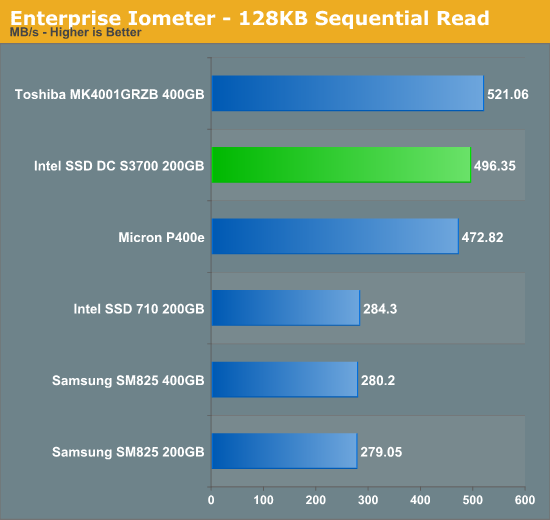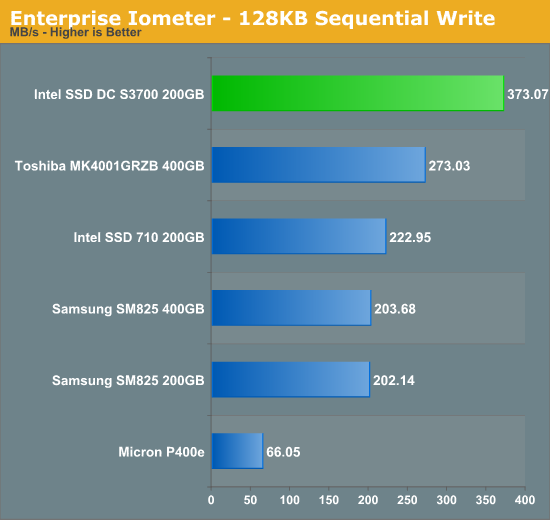The Intel SSD DC S3700 (200GB) Review
by Anand Lal Shimpi on November 9, 2012 8:01 AM EST- Posted in
- Cloud Computing
- Storage
- IT Computing
- SSDs
- Intel
Sequential Read/Write Speed
Similar to our other Enterprise Iometer tests, queue depths are much higher in our sequential benchmarks. To measure sequential performance I ran a 1 minute long 128KB sequential test over the entire span of the drive at a queue depth of 32. The results reported are in average MB/s over the entire test length.

As Intel's first 6Gbps controller, there's a huge improvement in sequential IO compared to the outgoing 710. There are definitely still drives that put up beter performance numbers if we look at all of our consumer test data (mainly when it comes to sequential write performance), but Intel is at least in the realm of top performers and does very well compared to many current enterprise SSDs.











30 Comments
View All Comments
Hans Hagberg - Monday, November 12, 2012 - link
An enterprise storage review today is not really complete without an array of 15K mechanical disks for comparison. This is still what is being used for performance in most cases and that is what we are up against when we are looking to motivate SSDs in existing configurations.And for completeness, please throw in PCI-based SSD storage as well. Such storage always come up in discussions around SSD but there is too little independent test data available to take decisions.
Another question when reading the review is about the test system being used. I couldn't find this information?
Also - enterprise storage is most often fronted by high-end controllers with lot's of cache. It would be interesting to see an analysis of how that impacts the different drives and their consistency. Will the consistency be equalized by a big controller and cache in front of it?
The Swingbench anomaly is unfortunate because database servers are probably the primary application for massive implementation of SSD storage. It would be nice if the anomaly could be sorted out so we could see what the units can do. Normally, if one cares for enterprise performance, you are careful with alignment and separation of storage (data, logs etc.) so I agree with the Intel statement on this. Changing the benchmark would tear up the old test data so I'm not sure how to fix it without starting over.
The review format and test case selection is excellent. Just give us some more data points.
I would go as far as to say I would pay good money to read the review if the above was included.
Sb1 - Tuesday, November 13, 2012 - link
"An enterprise storage review today is not really complete without an array of 15K mechanical disks for comparison."... "And for completeness, please throw in PCI-based SSD storage as well."
I __fully__ agree with Hans Hagberg
I thought this was a good article, but it would be an excellent one with both of these.
Still keep up the good work.
Troff - Wednesday, November 14, 2012 - link
I agree as far as PCI-based SSDs go, but I see no point in including the 15K mechanical drive array for the same reason you don't see velocipedes in car reviews.ilkhan - Tuesday, November 13, 2012 - link
So what I see here is that for an enterprise server drive, go with this Intel. For a desktop drive, this intel or a samsung 840pro, for a laptop drive, the samsung 840pro is best.That about sum it up?
korbendallas - Friday, November 16, 2012 - link
Instead of average and max latency figures, I would love to see percentiles: 50%, 90%, 99%, 99,9% for instance. If you look at intel's claims for these drives, they're in percentiles too.If your distribution does not follow a bell curve, which is the case in many of the SSDs you are testing, average is useless. And as you already know (and why you didn't include it before now), max is useless too.
dananski - Saturday, November 17, 2012 - link
I'd really like to see more graphs like the ones on "Consistent Performance: A Reality" showing how much variation drives can have in instantaneous IOPS. These really do a great job of showing exactly what Intel has fixed and I can see the benefit in some enterprise situations. A millisecond hiccup is an eternity for the CPU waiting for that data.Personally I'd now like to know:
* How much of a problem this can be on consumer drives, where sustained random IO is less common?
* Is this test a good way to characterise the microstutter problem for a particular drive?
* How badly are drives with uneven IOPS distributions affected by RAID? (I know this was touched on briefly in the webcast with Intel)
junky77 - Sunday, November 18, 2012 - link
the consistency of current consumer SSDs?virtualstorage - Tuesday, March 12, 2013 - link
I see the test results upto 2000 seconds. With a enterprise array, there will be continuos ios in 24/7 production environment. What is the performance behavior of Intel SSD DCS3700 with continuous io's over many hours?damnintel - Wednesday, March 13, 2013 - link
heyyyy check this out damnintel dot comrayoflight - Sunday, October 6, 2013 - link
Got two of these. Both of them failed after approx. 30 boot up's. They arent recognised anymore by the bios or as external harddrives on a different system, as if they are completely dead. Faulty batch? Or do they "lock up" ? Anyone had this problem?